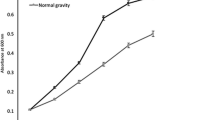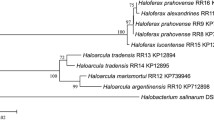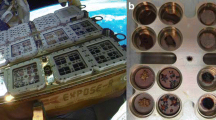Abstract
The survival of archaeabacteria in extreme inhabitable environments on earth that challenge organismic survival is ubiquitously known. However, the studies related to the effect of hypergravity on the growth and proliferation of archaea are unprecedented. The survival of organisms in hypergravity and rocks in addition to resistance to cosmic radiations, pressure and other extremities is imperative to study the possibilities of microbial travel between planets and endurance in hyperaccelerative forces faced during ejection of rocks from planets. The current investigation highlights the growth of an extremophilic archaeon isolated from a rocky substrate in hypergravity environment. The haloalkaliphilic archaeon, Natronococcus jeotgali RR17 was isolated from an Indian laterite rock, submerged in the Arabian sea lining Coastal Maharashtra, India. The endolithic haloarchaeon was subjected to hypergravity from 56 – 893 X gusing acceleration generated by centrifugal rotation. The cells of N. jeotgali RR17 proliferated and demonstrated good growth in hypergravity (223 X g). This is the first report on isolation of endolithic haloarchaeon N. jeotgali RR17 from an Indian laterite rock and its ability to proliferate in hypergravity. The present study demonstrates the ability of microbial life to survive and proliferate in hypergravity. Thus the inability of organismic growth in hypergravity may no longer be a limitation for astrobiology studies related to habitability of substellar objects, brown dwarfs and other planetary bodies in the universe besides planet earth.




Similar content being viewed by others
References
Abbes, M., Baati, H., Guermazi, S., Messina, A., Santulli, A., Gharsallah, N., et al.: Biological properties of carotenoids extracted from Halobacterium halobium isolated from a Tunisian solar saltern. BMC Comple. Altern. M 13, 255–262 (2013). doi:10.1186/1472-6882-13-255
Barnes, R., Heller, R.: Habitable planets around white and brown dwarfs: the perils of a cooling primary. Astrobiology 13(3), 279–291 (2013). doi:10.1089/ast.2012.0867
Bauer, A.W., Kirby, W.M., Sherris, J.C., Turck, M.: Antibiotic susceptibility testing by a standardized single disk method. Am. J. Clin. Path. 45, 493–6 (1966)
Benoit, M.R., Klaus, D.M.: Microgravity, bacteria, and the influence of motility. Adv. Space Res. 39, 1225–1232 (2007)
Bouloc, P., D’Ari, R.: Escherichia coli metabolism in space. J. Gen. Microbiol. 137, 2839–2843 (1991)
Brown, R.B., Klaus, D., Todd, P.: Effects of space flight, clinorotation and centrifugation on the substrate utilization efficiency of E, coli. Microgravity Sci. Tec. 13, 24–29 (2002)
Carillo, P., Mastrolonardo, G., Nacca, F., Parisi, D., Verlotta, A., Fuggi, A.: Nitrogen metabolism in durum wheat under salinity: accumulation of proline and glycine betaine. Funct. Plant Biol. 35, 412–426 (2008)
Clinical Laboratory Standards Institute: Performance standards for antimicrobial disc susceptibility tests, Twenty second Informational supplement. Tech. Rep. M100-S22. CLSI. Wayne. PA.USA. 32.3 (2012)
Clinical Laboratory Standards Institute: Performance standards for antimicrobial disc susceptibility tests, Twenty fourth Informational supplement. Tech. Rep. M100-S24. CLSI. Wayne. PA. USA, vol. 34 (2014)
Crits-Christoph, A., Gelsinger, D.R., Ma, B., Wierzchos, J., Ravel, J., Davila, A., Casero, M.C., DiRuggiero, J.: Functional interactions of archaea, bacteria and viruses in a hypersaline endolithic community. Environ Microbiol. doi:10.1111/1462-2920.13259 (2016a)
Crits-Christoph, A., Robinson, C.K., Ma, B., Ravel, J., Wierzchos, J., Ascaso, C., Artieda, O., Souza-Egipsy, V., Casero, M.C., DiRuggiero, J.: Phylogenetic and functional substrate specificity for endolithic microbial communities in hyper-arid environments. Front Microbiol. 7, 301 (2016b). doi:10.3389/fmicb.2016.00301.
Damm, T.B., Franco-Obregón, A, Egli, M.: Gravitational force modulates G2/ M phase exit in mechanically unloaded myoblasts. Cell Cycle 112, 3001–3012 (2013). doi:10.4161/cc.26029
DasSarma, S.: Extreme halophiles are models for astrobiology. Microbe 1(3), 120–126 (2006)
Deguchi, S., Hirokazu, S., Mikiko, T., Sada-atsu, M., Corkeryc, R.W., Susumu, I., Koki, H.: Microbial growth at hyperaccelerations up to 403,627 × g. PNAS 108, 7997–8002 (2011)
Denner, E.M.B., McGenity, T.J., Busse, H., Wanner, G., Grant, W.D., Stan-Lotter, H.: Halococcus sulfodinae sp, nov, an archaeal isolate from an Austrian salt mine. Int. J. Syst. Bacteriol. 44, 774–780 (1994)
Dornmayr-Pfaffenhuemer, M., Legat, A., Schwimbersky, K., Fendrihan, S., Stan-Lotter, H.: Response of Haloarchaea to simulated microgravity. Astrobiology 11, 199–205 (2011)
Fendrihan, S., Legat, A., Pfaffenhuemer, M., Gruber, C., Weidler, G., Gerbl, F., et al.: Extremely halophilic archaea and the issue of long- term microbial survival. Rev. Environ. Sci. Biotechnol. 15, 203–218 (2006)
Galinski, E.A., Trüper, H G: Microbial behaviour in salt stressed ecosystems. FEMS Microbiol. Rev. 15, 95–108 (1994)
Genchi, G., Cialdai, F., Monici, M., Mazzolai, B., Mattoli, V., Ciofani, G.: Hypergravity stimulation enhances PC12 neuron-like cell differentiation. BioMed. Res. Int., 748121 (2015). doi:10.1155/2015/748121
Govekar, R., Kawle, K., Thomas, R., Advani, S., Sheena, P.V., Zingde, S.: Eryptotic phenotype in chronic myeloid leukemia: contribution of neutrophilic cathepsin G. Anemia (2012). doi:10.1155/2012/659303
Hershkovitz, N., Oren, A., Cohen, Y.: Accumulation of trehalose and sucrose in cyanobacteria exposed to matric water stress. Appl. Environ. Microbiol. 57, 645–648 (1991)
Jagtap, S.S., Awhad, R.B., Santosh, B., Vidyasagar, P.B.: Effects of clinorotation on growth and chlorophyll content of rice seeds. Microgravity Sci. Tec. 23, 41–48 (2011)
Jin, Y., Wang, M., Lin, S., Guo, Y., Liu, J., Yin, Y.: Optimization of extraction parameters for trehalose from beer waste brewing yeast treated by high-intensity pulsed electric fields (PEF). Afr. J. Biotechnol. 10 (82), 19144–19152 (2011)
Kato, Y., Mogami, Y., Baba, S.A.: Responses to hypergravity in proliferation of Paramecium tetraurelia. Zoology Sci. 20, 1373–1380 (2003)
Kim, O.S., Cho, Y.J., Lee, K., Yoon, S.H., Kim, M., Na, H., Park, S.C., Jeaon, Y.S., Lee, J.H., Yi, H., Won, S., Chun, J.: Introducing EzTaxon-e: a prokaryotic 16S rRNA gene sequence database with phylotypes that represent uncultured species. Int. J. Syst. Evol. Microbiol. 62, 716–721 (2012)
Koval, S.F., Sprott, G.D.: Cell fractionation. In: Reddy, CA et al. (eds.) Methods for General and Molecular Microbiology Washington, DC: ASM Press, pp. 108–137 (2007)
Kumar, V., Khare, T.: Individual and additive effects of Na+ and Cl− ions on rice under salinity stress. Arch. Agron. Soil. Sci. 61(3), 381–395 (2015)
Laemmli, U.K.: Cleavage of structural proteins during the assembly of the head of bacteriophage T4. Nature 227, 680–685 (1970)
Leggett, S.K., Cushing, M.C., Saumon, D., Marley, M.S., Roellig, T.L., Warren, S.J., et al.: The physical properties of four ∼600 K T dwarfs. Astrophys J. 695, 1517–1526 (2009)
Mancinelli, R., White, M.R., Rothschild, L.J.: Biopan survival I: exposure of the osmophiles Synechococcus sp (Nägeli) and Haloarcula sp. to the space environment. Adv. Space Res. 22, 327– 334 (1998)
Mastrapa, R.M.E., Glanzberg, H., Head, J.N., Melosh, H.J., Nicholson, W.L.: Survival of bacteria exposed to extreme acceleration: implications for panspermia. Earth Planet Sci. Lett. 189, 1–8 (2001)
Nicholson, W.L., Munakata, N., Horneck, G., Melosh, H.J., Setlow, P.: Resistance of Bacillus endospores to extreme terrestrial and extraterrestrial environments. Microbiol. Mol. Biol. Rev. 64, 548–572 (2000)
Norton, C.F., McGenity, T.J., Grant, W.D.: Archaeal halophiles (halobacteria) from two British salt mines. J. Gen. Microbiol. 139, 1077–1081 (1993)
Oren, A., Ventosa, A., Grant, W.D.: Proposed minimal standards for description of new taxa in the order Halobacteriales. Int. J. Syst. Bacteriol. 47, 233–238 (1997)
Oren, A.: Microbial life at high salt concentrations: phylogenetic and metabolic diversity. Saline Systems 4, 2 (2008). doi:10.1186/1746-1448-4-2
Otte, K., Frohlich, T., Arnold, G., Laforsh, C.: Proteomic analysis of Daphnia magna hints at molecular pathways involved in defensive plastic responses. BMC Genomics 15, 306 (2014). doi:10.1186/1471-2164-15-306
Purevdorj-Gage, B., Sheehan, K.B., Hyman, L.E.: Effects of low- shear modeled microgravity on cell function, gene expression, and phenotype in Saccharomyces cerevisiae. Appl. Environ. Microbiol. 72, 4569–4575 (2006)
Roh, S.W., Nam, Y.D., Chang, H.W., Sung, Y., Kim, K.H., Lee, H.J., Oh, H.M., Bae, J.W.: Natronococcus jeotgali sp. Nov. a halophilic archaeon isolated from shrimp jeotgal, a traditional fermented seafood from Korea. Int. J. Syst. Evol. Microbiol. 57, 2129–2131 (2007)
Rothschild, L.J., Mancinelli, R.L.: Life in extreme environments. Nature 409, 1092–1101 (2001)
Salgaonkar, B., Das, D., Braganca, J.: Resistance of extremely halophilic archaea to zinc and zinc oxide nanoparticles. Appl. Nanosci. 6, 251–258 (2015)
Schellmann, W.: Considerations on the definition and classification of Laterites. Lateritisation processes, pp 1–10. Oxford and IBH Publishing Co, New Delhi (1981)
Sehgal, S.N., Gibbons, N.E.: Effect of some metal ions on the growth of Halobacterium cutirubrum. Can. J. Microbiol. 6, 165–169 (1960)
Sharma, A., Dhar, S., Prakash, O., Vemuluri, V.R., Thitte, V., Shouche, Y.: Description of Domibacillus indicus sp. Nov. isolated from ocean sediments of Lakshadweep and emended description of the genus Domibacillus. Int. J. Syst. Evol. Microbiol. 64, 3010–3015 (2014)
Springer, B., Kidan, Y.G., Prammananan, T., Ellrott, K., Böttger, EC, Sander, P.: Mechanisms of streptomycin resistance: selection of mutations in the 16S rRNA gene conferring resistance. Antimicrob. Agents Chemother. 45(10), 2877–2884 (2001). doi:10.1128/AAC.45.10.2877-2884.2001
Thombre, R.S., Oke, R.O.: Study of stress proteins induced by temperature stress in extremely halophilic archaea, Haloferax mediterranei RT18. Int. J. Curr. Microbiol. App. Sci. 2, 199–209 (2015)
Thombre, R., Shinde, V., Oke, R., Dhar, S., Shouche, Y.: Biology and survival of extremely halophilic archaeon Haloarcula marismortui RR12 isolated from Mumbai salterns, India in response to salinity stress. Sci. Rep. 6, 25642 (2016a). doi:10.1038/srep25642
Thombre, R.S., Shinde, V., Thaiparambil, E., Zende, S., Mehta, S.: Antimicrobial activity and mechanism of inhibition of silver nanoparticles against extreme Halophilic archaea. Front. Microbiol. 7, 1424 (2016b). doi:10.3389/fmicb.2016.01424
Tindall, B.J., Ross, H.N.M., Grant, W.D.: Natronobacterium gen. nov. and Natronococcus gen. nov. two new genera of Haloalkaliphilic archaebacteria. Syst. Appl. Microbiol. 5, 41– 57 (1984)
Trotter, B., Otte, K., Schoppmann, K., Hemmersbach, R., Fröhlich, T, Arnold, G., et al.: The influence of simulated microgravity on the proteome of Daphnia magna. npj Microgravity 1, 15016 (2015). doi:10.1038/npjmgrav.2015.16
Vadagbalkar, S.K.: Study of laterites around Talmod, Maharashtra state. India International Science Journal 1(2), 10–14 (2014)
Widdowson, M., Cox, K.G.: Uplift and erosional history of the Deccan Traps, India: evidence from laterites and drainage patterns of the Western Ghats and Konkan Coast. Earth Planet Sci. Lett. 137, 57–69 (1996)
Wilson, J.W., Ott, C.M., HönerzuBentrup, K., Ramamurthy, R., Quick, L., Porwollik, S., et al.: Space flight alters bacterial gene expression and virulence and reveals a role for global regulator Hfq. PNAS 104, 16299–16304 (2007)
Acknowledgments
This research was supported by a grant from Indian Space Research Organization (ISRO) –Space Technology Cell-University of Pune (STC-UoP), Grant no. 140 to RT. VS thanks ISRO for Junior research fellowship. We thank Dr. P.P. Kanekar for suggestions regarding sampling site and sampling and Ms. Oke R for biochemical characterization. We thank Principal, Modern College, Shivajinagar, Pune for providing necessary facilities for the work and Prof. Dr. P.D. Sabale, Dept. of Archaeology, Deccan College, Pune for help in identification of rock.
Author information
Authors and Affiliations
Corresponding author
Ethics declarations
Conflict of interests
The authors declare that they have no competing interests.
Ethical Approval
This article does not contain any studies conducted with human participants or animals performed by any of the authors.
Electronic supplementary material
Below is the link to the electronic supplementary material.
Rights and permissions
About this article
Cite this article
Thombre, R.S., Bhalerao, A.R., Shinde, V.D. et al. Response of Haloalkaliphilic Archaeon Natronococcus Jeotgali RR17 to Hypergravity. Microgravity Sci. Technol. 29, 191–200 (2017). https://doi.org/10.1007/s12217-017-9538-9
Received:
Accepted:
Published:
Issue Date:
DOI: https://doi.org/10.1007/s12217-017-9538-9




